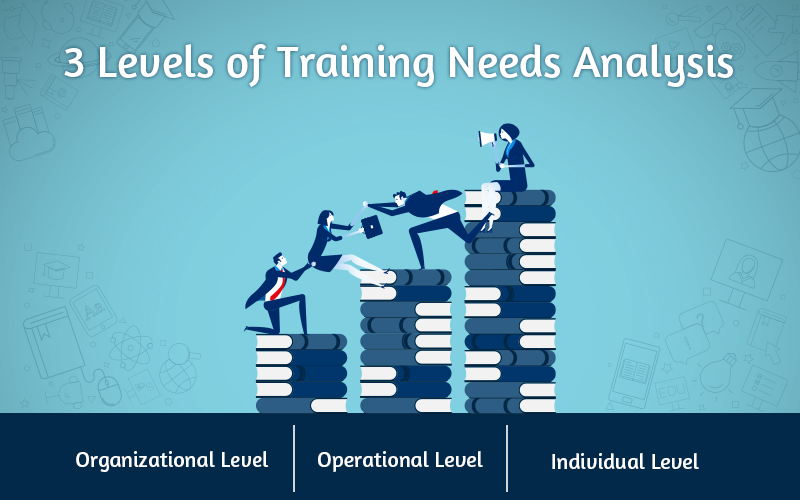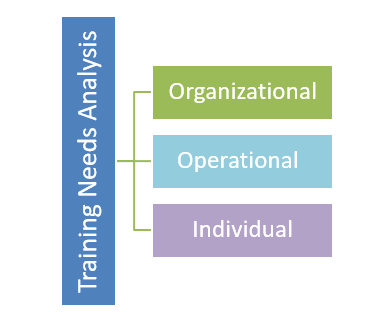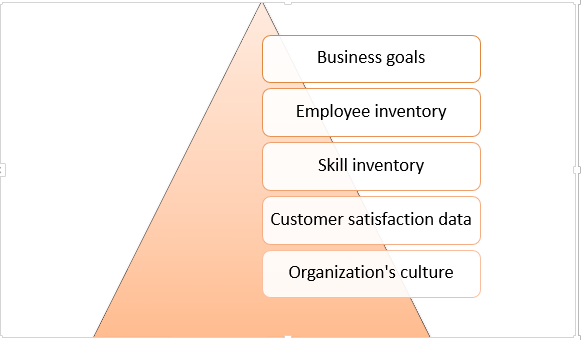3 Levels of Training Needs Analysis in Corporate Learning (Part 3)
Here’s a blog on the 3 levels at which training needs analysis is conducted. Find out how each level of TNA contributes to effective corporate learning.

If you have read our previous blogs in the series on training needs analysis (TNA) on what is training needs analysis and what are its benefits, you’d agree with me that no matter what your training methodology is – classroom training, eLearning, or blended learning, conducting a TNA is an essential step before embarking on developing corporate training. This blog on the levels at which TNA is conducted in organizations is the third one in the series.
What are the Levels of Training Needs Analysis?
- Training Needs Analysis at the Organizational Level
- Find out where training is needed
- Training Needs Analysis at the Operational Level
- Find out the KSAs needed to complete tasks efficiently
- Training Needs Analysis at the Individual Level
- Determine who needs training and for which task
The Three Levels of Training Needs Analysis
Conducting an effective TNA (aka learning needs analysis, LNA) can help you see the big picture in corporate learning and development. There are different approaches to conducting TNA, but one that’s commonly followed is McGhee and Thayer’s Three Level Analysis. According to this model, training needs analysis can be done at three different levels.

Let’s see what is done at each level of TNA.
1. Training Needs Analysis at the Organizational Level
While most organizations invest in employee training, year after year, not every training program is aligned with business goals. Training needs analysis at the organizational level will help identify training programs that would help achieve the strategic business objectives of the organization.
How can eLearning help you achieve business goals? To find out, download this free eBook.
Data Sources used to Conduct TNA at the Organizational Level
Here are a few examples:

“If you don’t know where you are going, any road will get you there” (as the cat said to Alice), doesn’t always hold true. Without knowing the goals of the organization, it is well-nigh impossible to determine if training is actually necessary. If you go ahead and develop training programs without considering the organizational goals, chances are your training program is doomed to fail.

TNA at the organizational level is a macro level analysis that helps identify areas where the employees of the organization lack necessary knowledge or skills and provides need-based training. It helps answer the following questions:
- Where is training most needed? (Is it for a specific department or a group of employees?)
- Why is the training program recommended as a solution to a business problem?
TNA at the organizational level can clearly define measurable outcomes for a training and thus improve the chances of success of the training program.
| Example of TNA at the Organizational Level
Here’s an example. An insurance company’s Claims Processing department continually receives poor feedback from customers, and the company obviously wants to improve its customer service rankings. An organizational level analysis reveals an issue in claims processing and identifies the need for training agents involved in claims processing. TNA can also explain why the training program is recommended as a solution and how it can contribute to the company’s goal of improving customer service. |
2. Training Needs Analysis at the Operational Level
At the operational level (aka task/job level), training needs analysis determines what kind of training needs to be given to employees to achieve a specified level of proficiency. This analysis can help identify the knowledge and skills required to perform specific jobs at the workplace.
Data Sources used to Conduct TNA at the Operational/Task Level
A few examples of data sources that can be used at this level are:

Task analysis assesses the knowledge and skills required for specific job tasks and correlates these requirements to the workforce’s actual knowledge and skills. The training needs can be identified from the gaps revealed in this analysis.
TNA at the operational level answers the following questions:
- How is a job performed?
- What are the expected performance standards for the job?
- How should the work/task be done in order to meet the performance standards?
- What are the knowledge, skills, and abilities required to complete the job successfully?
| Example of TNA at the Operational Level
Let’s continue with the same example of the insurance company. Operational or task analysis identifies what should be done to increase the number of claims processed error free. It also lists the knowledge and skills required to successfully process a claim, in accordance with defined performance standards. |
3. Training Needs Analysis at the Individual Level
At the individual or personal level, TNA checks how each employee performs in his/her job role. The difference between the expected performance and the actual performance helps you arrive at the training need.

Is there really a need for TNA at the individual level? Won’t employees identify their training needs themselves? After all, they’re the ones executing the tasks and they should know where they need to improve. But unfortunately, this doesn’t happen.
According to the Dunning-Kruger effect, most incompetent people do not realize they are incompetent. On the contrary, people not very good at their jobs are extremely confident of their abilities, even more than people who do their jobs well. So, a TNA at the individual level becomes absolutely necessary.
Data Sources used to Conduct TNA at the Individual Level

Training needs analysis at the individual level gives you a complete picture of employee performance and whether their performance meets expected standards, and can help you answer the following questions:
- What is the desired performance?
- Does the employee have the necessary skills and knowledge?
- What is the gap between the desired and actual performance?
- What are the obstacles to efficient performance?
- What training must be provided to the employee to meet desired performance standards?
| Example of TNA at the Individual Level
Going back to the same example, here’s what training needs analysis at the individual or personal level can do. It can identify the knowledge, skills, and abilities (KSAs) that each employee is required to focus on – For example, one employee might need to focus on improving claim analysis skills whereas another might need help in interpreting policies and claim calculations. |
With online training, it has become possible to take learners on different pathways, depending on the information they need to know to excel at their job.
Wrap Up
Here’s a quick summary of the big picture that training needs analysis reveals.
| Level of Analysis | What it Does |
| Organizational Analysis | Analyzes organization-wide goals and problems to find out where training is needed |
| Operations/Task Analysis | Examines jobs/tasks actually performed and the KSAs employees need to attain organizational objectives |
| Individual/Personal Analysis | Analyzes the actual knowledge, skills, and current performance of each employee while performing tasks to determine who needs training and in which area/s |
These three interlinked TNA levels can help you take the step toward designing effective training solutions. Also, conducting this analysis at different levels helps you plan for the design and development of training programs throughout the year. What’s more, you can be assured that these training programs will be designed to meet organizational, team, and individual goals.
To get more information on the steps to conduct training needs analysis, read our next blog in this series.
Do you conduct TNA at these three levels before designing and implementing training solutions? If yes, we’d love to hear your experiences on conducting a TNA and how it helped improve your training programs.





